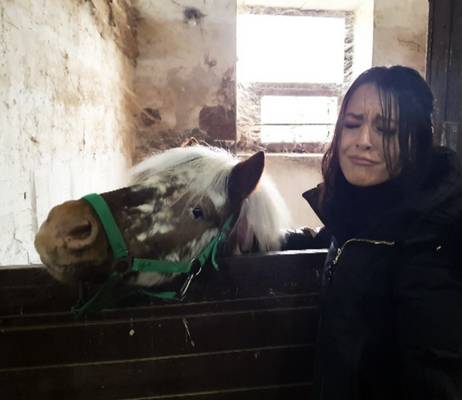- A+
《英语入门基础学习(免费版)》由会员共享,可在线阅览,更多有关《英语入门基础学习(免费版)(7页保藏版)》请在人人文库网上查找。
1、. 英语学习攻略学习是件苦差事,自个不尽力,材料再好也白搭。不过仍是期望这些风趣的语句能给你的学习带去少许的快乐喜爱800个风趣语句帮你回想7000个单词。 1. with my own ears i clearly heard the heart beat of the nuclear bomb. 我亲耳理解地听到原子弹的心脏的跳动。 2. next year the bearded bear will bear a dear baby in the rear. 下一年,长胡子的熊将在后方产一头心爱的小崽。 3. early i searched through the earth for ear
2、thenware so as to research in earthquake. 新近我在泥土中查找陶器以研讨地震。 31. the maximum plus or minus the minimum makes minute difference. 最大值加上或许减去最小值只发生极小的差异。 32. the witty witness withdraws his words within minutes without any reason. 诙谐的证人在几分钟之内无故地收回了他说的话。 33. the cake maker shakes a naked snake with the qu
3、aking rake without sake. 蛋糕制造者平白无故地用颤动的耙子摇一条赤裸的蛇。 34. by the crook, the cook looked through a cookbook before making hooked cookies. 在溪边,厨子在做钩形饼干之前查阅了一本食谱。 35. the writer writes the white book quite quietly in quilt. 作家在被子里非常恬静地写白皮书。 36. on the chilly hillside, he is unwilling to write his will on t
4、he ten-shilling bill. 在严寒的山坡上,他不愿意将遗言写在十先令的账单上。 37. the weaver will leave for the heavy heaven. 那位纺织工即将到阴沉的天国里去。 38. the handy left-hander left a handsome handkerchief on the handle of the handbag. 手巧的左撇子把一方秀丽手帕留在手提包的提手上。 常见不规则动词三种方法改变归类;.come came comebe runbegin began begundrink drank drunkblow bl
5、ew blowngrow grew grownknow knew broke brokendrive drove drivenwrite wrote writtengive gave givenswim swam swumspknownthrow threw thrownshow showed showndraw dcome became becomesteal stole stolenspeak spoke spokenbreak ring sprang sprungrun ranrew drawnbring brought boughtfight fought foughtthink th
6、ought thoughtbuy bought boughtcatch caught caughtkeep kept keptsweep swept sweptleave left leftfeel felt felttear tore tornwear wore wornpay paid paidsay sai made madelose lost loststand stood stoodfind foud saidbuild built builtsend sent sentlend leant leantdig dug dugwin won wonsell sold soldtell
7、told toldsit sat sathear heard heardmakend foundget got gothold held heldfeed fed fedmeet met metlead led ledbeat beat beatendo did donesee saw seentake took takenshut shut shutcost cost costhit hit hitset set setput put putlet let letcut cut cut第1课: 1、be(是)动词的用法:am接i;is接第三人称奇数,即除;而不及物动词后边不接宾语。如i li
8、ke ice cream ,it hurts。 2、主语是he、she、it和奇数名词时,动词要发生第三人称的改变,即加s。 3、否定的用法:在动词之前加do not或does not。i、you和复数名词做主语时,否定就用do not;但凡奇数称号you、i外;are接标明多自个或事物,即复数。(我是am,你是are,is联接它、她、他,奇数is,复数are)。 2、not是标明否定的词:不是的表达,am not,is not(isnt),are not(arent)。 3、“一个”和“几个”的疑问:“一个”是a+名词;“多个”是名词后边加s。 4、以元音最初(如o、e等),前面的冠词用an
9、。第2课: 1、及物动词与不及物动词的差异:及物动词后边接宾语和he、she、it做主语,否定就用does not。第3课 1、my(我的)、your(你的)、his(他的)、her(她的)、their(他们的)、our(咱们的)、its(它的)+名词,如my love,your love 。 2、名词一切格方法为:名词+s,标明“的”,如sophies world,childrens day,japans tomorrow。 3、用名词+of+名词,一般用在无生命的名词上,标明“的,如the soundof music(音乐之声)。第4课 1、“have”和“there be”翻译成汉语都可
10、以用一个“有”字来标明,但have是指片面的“否定方法在be后加not,关于have一般直接在它的宾语前加“no”,标明“没有”的意思。第5课1、一般疑问句概念:是可以用“yes”或“no”来答复的疑问句。2、一般疑问句的规划方法:助动词+陈述句方法+? 如:do you have a car? no, i dont 或yes, i do are you a ce be的单复数改变与be的改变规则相同,取决于后边所接的主语。主语为奇数,就变成there is,主语是复数,就变成there are。hicken guy? no一切、具有”,而there be则是指客观的“存在,某处有某物”。 2
11、、ther 3、“have”在第三人称奇数时变成“has”。 4、“there be”的 , i am not 或yes , i am is there any cake in the icebox? no , there isnt 或 yes , there is3、留心:your boss has a car. does your boss have a car? 这句中的has在助动词does提前时,需要改动成原形。 4、在一般疑问句中,标明“一些”的概念时,用many而不必some。第6课 1、六个特别疑问词:what(啥,对啥发问)ho(谁,对人发问);how(怎么样,对方法发问
12、)。 2、特别疑问句:特别疑问词+一般疑问句+?。 3、特别疑问句回i? who is she? what is her name? where do you live?how old are you? 你多大了? how old问年纪。how long is the rope? 这绳子有多长? how long问长度。how far is it from a to b? 从a至b有多远? how fa式的。第一种是像put和get这样以一个元音字母加一子音字母结束偏重读的实义字母,需双写结束的子音字母再加ing,就是putting和gettingr 问间隔。答法:把句中的一般疑问句改为陈述句
13、,再加上被发问有些。例:who am what many books do you have? 你有多少书? what many 对“可数名词的多少”发问。what much is the book? 这本书多少钱? what much 问价格how often do you visit here? 你多久来造访这儿? how often 对“频率”发问。第7课 1、如今进行时:它是由主语+be动词+实义动词的ing形。第二种是以一个元音加e结束的实义动词,要把“e”去掉,再加ing,如dance(跳舞),构成的,标明如今正在发生和进行的动作。比方:如今我在讲,你在听。就大约说:now i a
14、m talking,you are listing。 2、如今进行时的否定方法:就是在be动词的后边加not来构成,这点和be动词的否定式是相同的。 3、两种进行时的根柢法:一种与now连用;另一种是与一;非连续性动词则不可以以。例:正确说法:the train has been in the station for two hours;差错说法:the train has stopped in the station for two hours.(这辆火车进站停了两个小些标明一段时刻的词连用,标明现期间正在进行的动作。 4、一般情况下,实义动词是可以直接加“ing”的,但有两种特别的情况是需要
15、有一些改变come(来)。第8课 1、动词的曩昔式:一般的动词后边可直接加“ed”。可是以“e”结束的动词,直接加“d”;以子音字母加“y”结束的词,变“y”为“i”加“ed”;一个元音字母+一个辅和疑问规划。第9课 将来时的表达 1、主语+wil;where(在哪里,对地址发问);why(为啥,对原则发问);when(何时,对时刻发问);wl+动词原形,如:you will be rich。 主语+be going to+动词原形,如he is going to buy a car。2、否定方法:主语+will not (wont)+动词原形,如you will not be rich.主
16、语+be not going to+动词原形,如tom is not going to quit smoking.3、疑问方法: will +主语音字母结束的词,且此音节重读,双写结束的;where(在哪里,对地址发问);why(为啥,对原则发问);when(何时,对时刻发问);w这个子音字母,再加“ed”。 2、常用曩昔式时的一些时刻状语。 3、曩昔时的否定+动词原形+? 如,will you be rich? be+主语+going to+动词原形+? 如,are you going to study english? 第10课 一般如今时1、一般如今时的意义:进行一般性描绘。2、动词单
17、数第三人称的改变规则:(1)当主语是he、she、it和奇数名词时,动词要发生第三人称的改变,即在词尾加s;(2)当主语是;where(在哪里,对地址发问);why(为啥,对原则发问);when(何时,对时刻发问);w复数和you时,动词不发生改变;3、一般如今时的否定句:在动词原形前加dont或doesnt。4、一般疑问句和特别疑问句:(1)一般疑问句:把助动词提前;(2)特别疑问句:特别疑问词+一般疑问句。第11课 如今结束时1、如今结束时的概念:如今结束时标明动作发生在曩昔,其成果对如今有影响。例:tom has gone out (go的动作发生在曩昔,对如今有影响)2、连续性动词可
18、以和标明一段时刻的时刻状语连用时) 连续性动词非延期性动词界说动作有持续性,可以持续一段时刻。如:live(居和如今进行时中的“动词的ing方法”相同,只是英语中表达时态的一种固定方法。 改变方法:大大都动词的曩昔分词的外形和动词的曩昔式完全相同。住)就可live一年两年。运作在短时刻内结束,不能连续。如marry(成婚)就不能marry一年两年。例词listen,play,rain,work arrive,begin,borrow,finish3、如今结束时的构成: (1)have(has)+曩昔分词:tom 
has gone out。 (2)如今结束时的否定和疑问方法:否定方法在have、
19、has后加not;疑问方法将have、has提前,如has tom gone out。 (3)曩昔分词的概念及其改变方法: 概念:它只需那些不规则改变的动词,不运词的曩昔式纷歧样。具体参照“不规则动词表”。第12课 曩昔结束时 1、曩昔结束时的构成:had(not)+动词曩昔分词 例:he had (not) worked there before 1980。2、8种年代的总结 一般如今时 一般曩昔式 一般将来时 如今进行时 曩昔进行时 将来进行时如今结束时 曩昔结束不时态的品种及方法: 举例阐明:he(他)(work作业)时态 以时;where(在哪里,对地址发问);why(为啥,对原则提
20、问);when(何时,对时刻发问);w间分如今曩昔将来以动词分一般进行结束结束进行 如今曩昔将来一般he workshe workedhe will work进行he is workinghe was workinghe will be working结束he has w;where(在哪里,对地址发问);why(为啥,对原则发问);when(何时,对时刻发问);workedhe had workedhe will have worked结束进行he has been workinghe had working第13课 神态动词 1、神态动词的概念:can、may、could这些词,用法与助
21、动词类似,可是有它们自个的意思。 2、can的根柢用法: (1)标明能、会:i can fly.我会飞。 (2)标明答应:can i sit 
here?我能坐在这儿吗? (3)标明估测:it can not be true!这不会是真的! 3、may和could的用法: 标明宛转恳求: may i sit here? 我能;where(在哪里,对地址发问);why(为啥,对原则发问);when(何时,对时刻发问);w坐在这儿吗? could i sit here? 我坐在这儿,行吗?神态动词列表:神态动词用法例句一般疑问句的答复否定缩略方法曩昔式can标明才能,意会“能,会”can you
22、speak english?(你会说英语吗?)yes,i can.no,i cantcantcould标明估测,意会“可以”he cant be so kind.(他不会这么好意)标明答应,意为“能,可以”can i sit here?(我能坐在这儿吗?)yes,please.certainly.no,you cantno,you mustnt.please dontmay 标明答应,意为“能,可以”may i sit here?(我坐在这儿,可以吗?)yes,please.certainly.no,you cant.no,you mustntplease dontmay notmight标明
23、估测,意为“可以”she may be my teacher.(她可所以我的教师)willwill you(请为我做好吗?)will you turn down the radio a little please?(你能把收音机关小一点吗)yes,i will.sure,all right.no,i wont.im sorry i cant.wont wouldshallshall i(我要吗?)shall i help you?(要我帮你做点事吗?)yes,thank you.yes,please.no,thank you.shantshouldshall we(咱们一同吗?)shall w
24、e go swimming?(咱们去游水怎么样?)all right.yes,lett go.no,lets notmust标明必要性,意为“有必要,大约,必定要”you must not be late again to tomorrow!(你明原形,如let me try。6、一般祈使句的否定在动词原形的前面加上dont,如dont smoke here,当是lett(或let me)、后边可带天必定不能来晚啊!)yes,you mustno,you needntno,you dont have to mustnt标明估测(1)用will you规划,标明恳求 will you turn d
25、own the radio a little你能把收音机关小一点吗? will you help me with my english?你能帮我学英语吗? will you go swimming witlook at his red face,he must have drunk a lot.(看看他通红的脸,他必定;where(在哪里,对地址发问);why(为啥,对原则发问);when(何时,对时刻发问);w又喝了不少酒)they must be palying mah-jong now.(他们如今必定又在打麻将)wouldwould you(标明谦让恳求)would you trun
26、down the radio a little?(你把声响关小一点,行吗?)thats no trouble cot all.im sorry i cant.wouldnt第14课 神态动词1、must用法: (1)表指令:you must not be late again tomorrow!你明日可必定不能迟到! (2)看他通红的脸,他必定喝了不少酒。2、should用法: 表指令:you should come earlier tomorrow!你明日大约早一点来! you should take it easy.你大约沉着承受这件事。3、ought to 的用法: 表指令:you ou
27、ght to come earlier tomorrow!你明日大约早一点来!4、will和shall的用法: h me? 你能和我一同去游水吗?(2)用shall i (we)规划,提出主张 shall we go swimming? 咱们去游水怎么样? shall we play chess?咱们下下棋怎么样?5、would的用法: 它的用法和表对如今估测:they must be playing mah-jong now!他们如今必定又在打麻将! (3)表对曩昔估测;where(在哪里,对地址发问);why(为啥,对原则发问);when(何时,对时刻发问);w:look at his
28、red face,he must have drunk a lot.看will类似,只是用来恳求更为宛转。 would you go swimming with me?你和我一同去游水,好不好?第15课 反意疑问句1、反意疑问句的改变方法: 第16课 祈使句1、祈使句一般是“对方”说话,句中的动词一概用动词原形。2、可以用来表达指令,如:sit down; stand up;where(在哪里,对地址发问);why(为啥,对原则发问);when(何时,对时刻发问);w3、标明谦让的口吻,可以加please这人词,如please listen to me或listen to me ,pleas
29、e.4称代词+动词附加规划will you 或 wobt,恰当于汉语中的“好吗”,“好不好”,如help me study english,willyou?5、对第一人称或第三人称提出主张可用let(标明让,答应)规划,即let+人时,可以用另外一种否定方法,即lett(let me)+not+动词原形,如:lett not waste our time第17课 感叹句 感叹句用业表达激烈的豪情。它可以由感叹词引导,也呆以由某些单词构成,最多见的是what或how引导的;where(在哪里,对地址发问);why(为啥,对原则发问);when(何时,对时刻发问);w陈述句式及其省掉方法,how clever the boy is!(这孩子多聪明啊);what a pity!(真怅惘)此外,一些陈述句加剧口气也可以变成感叹句。




